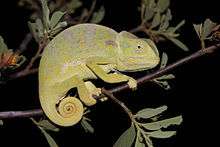Flap-necked chameleon
| Flap-necked chameleon | |
|---|---|
 | |
| Scientific classification | |
| Kingdom: | Animalia |
| Phylum: | Chordata |
| Class: | Reptilia |
| Order: | Squamata |
| Suborder: | Sauria |
| Family: | Chamaeleonidae |
| Genus: | Chamaeleo |
| Species: | C. dilepis |
| Binomial name | |
| Chamaeleo dilepis Leach, 1819 | |
| Synonyms | |
| |
The flap-necked chameleon (Chamaeleo dilepis) is a species of arboreal chameleon native to sub-Saharan Africa.
Taxonomy
There is considerable uncertainty about the taxonomic status of various described subspecies of the flap-necked chameleon. The following listing is not universally recognized and may contain local morphs:[1]
- Flap-necked chameleon, C. d. dilepis
- Idjwi Island flap-necked chameleon, C. d. idjwiensis
- Isabelline flap-necked chameleon, C. d. isabellinus
- Pemba Island flap-necked chameleon, C. d. martensi
- Peters' flap-necked chameleon, C. d. petersii
Description

This species is a large chameleon, reaching 35 cm (14 in). Colouring ranges through various shades of green, yellow, and brown. There is usually a pale stripe on the lower flanks and one to three pale patches higher on the flanks.[2]
Distribution and habitat
This species has a very wide distribution, occurring throughout much of sub-Saharan Africa from as far north as Ethiopia and Somalia to a western extreme of Cameroon, and as far south as northern South Africa. It inhabits coastal forest, moist or dry savannah, woodland and bushy grasslands, and may also venture into rural and suburban areas.[1]
Ecology
_female.jpg)
The flap-necked chameleon lays 10-40 eggs in a hole dug in soil, which take 10–12 months to hatch. Food includes a variety of invertebrates, although large individuals may take geckos and other chameleons. The species is itself commonly preyed on by snakes such as the boomslang and the twig snake.[1]
Captivity
This species does well in captivity. They are mostly active during the day. When these animals are in captivity, it is very important to create an environment very much like their natural climate. Their diet include crickets, mealworms, wax worms, and other locally caught insects. Their estimated life expectancy is 5–8 years.[3]
Conservation
The flap-necked chameleon is in heavy demand for the international pet trade, being the third most highly traded chameleon species. More than 111,000 individuals were exported between 1977 and 2011, mostly to the USA. No detrimental effects on the total population size have been observed so far, although more in-depth studies have been recommended. The species is currently classified as Least Concern by the IUCN.[1]
References
- 1 2 3 4 5 Tolley, K. (2014). "Chamaeleo dilepis". IUCN Red List of Threatened Species. IUCN. 2014: e.T176308A1438077. Retrieved 21 April 2016.
- ↑ Tolley, K.; Burger, M. (2007). Chameleons of southern Africa. Struik.
- ↑ "Flap Necked Chameleon - Lizard Types". Lizard Types. Retrieved 2016-04-20.
Further reading
- Branch, B. (1988). Field Guide to the Snakes and other Reptiles of Southern Africa. ISBN 0-86977-641-X.
| Wikimedia Commons has media related to Chamaeleo dilepis. |
